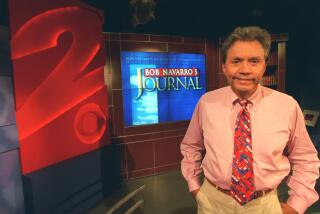Did Press Feed an ‘Ambassador’s’ Ego?
- Share via
FORT DAVIS, Texas — If Rick McLaren were just another yahoo with a gun, he probably wouldn’t have enjoyed even 15 minutes of fame, much less a full week in the media limelight.
Rifle-wielding fugitives holed up in ramshackle trailers, after all, are about as unusual as freeway pileups on a holiday weekend. It’s certainly not the sort of event that normally commands an international army of more than 100 journalists, everyone from Agence France-Presse to Playboy to the “Today” show to, well . . . the Los Angeles Times.
But add a little twist, maybe a dash of militant politics or a splash of Wild West folklore, and suddenly everything changes.
Let the yahoo with a gun call himself an “ambassador.” Let him describe his makeshift hide-out as an “embassy.” Let him invoke the Alamo and refer to his followers as “citizens” of an independent republic. And let him do it all in a rugged corner of the Lone Star State where there’s enough in the way of wide dusty plains and big starry skies and tall grizzled cowboys to fulfill every Texas stereotype.
Now you’re talking team coverage and banner headlines.
Which is not to say that McLaren’s pseudo-secessionist siege earlier this month in the Davis Mountains wasn’t newsworthy. Any time a few hundred police officers are summoned to smoke out a ragtag gang of lawbreakers, the moment deserves serious attention. The ghosts of Waco and Ruby Ridge will be there forever to remind us why.
Yet how do reporters respond to such an event without turning it into a farce? How do we explain the dynamics of the standoff without validating at least some of the half-cocked notions at its heart? And what about the next time and the time after that? Will every anti-government zealot who decides he’s really a sovereign potentate be guaranteed a spot on the evening news?
Richard Lance McLaren, you might recall, had no authority, except that of his own invention. When he surrendered, he had few followers, other than the seven “Republic of Texas” sympathizers hunkered down with him. He could scarcely even be thought of as a spokesman for the growing militia movement, given that rival factions within his own fringe group already had impeached him and charged him with treason.
What the 43-year-old, part-time vintner did have was a fax machine, a computer modem and a brilliant spin on Texas mythology, despite being a Missouri native.
“He’s not stupid,” said Tex Houston, 53, a local cowboy artist and tour promoter who himself well understands the value of tapping the state’s maverick spirit. Chain-smoking over breakfast one morning in the Drugstore, a frontier-era soda fountain in Fort Davis, he marveled at McLaren’s marketing skill with a mixture of revulsion and awe.
“Really, he’s a genius,” Houston said. “A mad genius.”
Inadvertently, perhaps unavoidably, the media played into McLaren’s charade. For seven days, many news organizations were literally camped out around the clock, their reporters sleeping in shifts so that the first signs of a conflagration, should one erupt, wouldn’t be missed.
Most of them had done stories on McLaren in the previous months, detailing the potential for just such a standoff. Now, they looked awfully prescient--or guilty of egging him on. As The Times’ Houston bureau chief, I hadn’t covered McLaren’s activities beforehand, which either revealed great restraint--or overly wishful thinking that he could be ignored.
True, almost everyone continued to pepper their reports with carefully placed qualifiers, such as “self-styled” and “so-called” when describing McLaren. But even putting “ambassador” and “embassy” inside quotations imparted a certain legitimacy to those terms. Several newspapers actually did entire stories analyzing McLaren’s claim that Texas was illegally annexed by the United States in 1845. The verdict: McLaren knows fantasy better than history. Still, he inspired thousands of words on a topic that is, in the most charitable light, moot.
“He loves this attention,” said Bob Dillard, a former county judge and newspaper publisher in Fort Davis who has watched McLaren transform himself from local eccentric into celebrity extremist. “It’s almost orgasmic for him.”
Even straight-faced police succumbed to McLaren’s let’s-play-fort jargon, referring to his isolated trailer as a “compound” and describing his many communiques as “diplomatic pouches.”
They also offered a few Lone Star aphorisms of their own, which helped make the entire showdown seem more like a spaghetti Western. “This is not the Alamo,” Texas Department of Public Safety spokesman Mike Cox quipped to reporters one day. “I’m not Davy Crockett.”
If there was any doubt about McLaren’s influence over the story, it quickly evaporated on May 3, when he surrendered, along with most of his compatriots. Two other members of the group seized the moment to escape, but hardly anyone seemed to care. Although the situation had grown arguably more volatile--one of the fugitives was later killed by police in a gunfight and the other is still missing and presumed dead in the bone-dry mountains--they had become, by that point, just a couple more yahoos with guns.
“This is a pretty routine manhunt,” Cox said on May 4. “Frankly, I’m ready to go home.”
By May 5, many reporters had.
More to Read
Sign up for Essential California
The most important California stories and recommendations in your inbox every morning.
You may occasionally receive promotional content from the Los Angeles Times.










